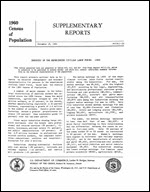1960 Census of Population, Supplementary Reports: Industry of the Experienced Civilian Labor Force: 1960
1960 Census of Population, Supplementary Reports: Industry of the Experienced Civilian Labor Force: 1960
The tables presented here are preprints of tables 210, 213, and 215 from Final Report PC(l)-lD, which contains additional summary information on the detailed characteristics of the population.
This report presents national data on industry by selected demographic and economic characteristics for persons in the experienced civilian labor force.
A number of major changes in the industrial distribution of American workers has occurred since the 1950 Census. Among the major industries, agriculture dropped by over 2.6 million workers, or 37 percent, in the decade, whereas manufacturing registered a 21-percent increase, representing a growth of 3.2 million in the number of workers. Durable goods manufacturing showed a greater proportionate increase (29 percent) than nondurable goods (14 percent) over the ten-year period.
Other major industries showing large relative increases over the decade were professional and related services (58 percent), finance, insurance, and real estate (41 percent), and public administration (27 percent). Of the 2.8 million increase in professional and related service workers, the component industries--educational services and hospitals--accounted for over 2 million.
Industries showing substantial declines were coal mining (-56 percent), railroads and railway express (-31 percent), and textile mill products (-21 percent).
The median earnings in 1959 of the experienced civilian labor force varied considerably among the industries. For men, the median earnings was $4,621, with the highest ($7,547) occurring in the legal, engineering, and miscellaneous professional services group. For women, the median earnings amounted to less than half that of men ($2,257).
The PDF to the right contains the 9-page report.
A Note on Language
Census statistics date back to 1790 and reflect the growth and change of the United States. Past census reports contain some terms that today’s readers may consider obsolete and inappropriate. As part of our goal to be open and transparent with the public, we are improving access to all Census Bureau original publications and statistics, which serve as a guide to the nation's history.




